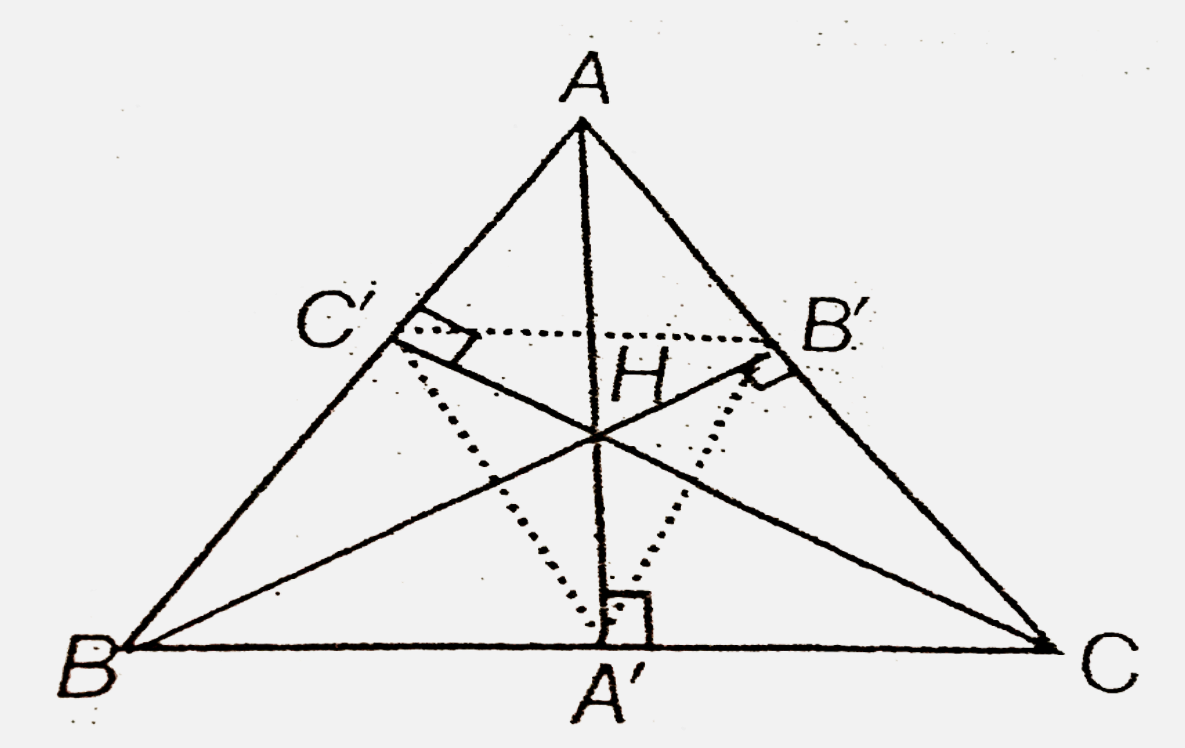In an acute angle ΔABC, let AD, BE and CF be the perpendicular from A, B and C upon the opposite sides of the triangle. (All symbols used have usual meaning in a tiangle.)
The orthocentre of the ΔABC, is the
centroid of the ΔDEF
circum-centre of the ΔDEF
incentre of the ΔDEF
orthocentre of the ΔDEF
The correct Answer is:C
Step by step video & image solution for In an acute angle Delta ABC, let AD, BE and CF be the perpendicular from A, B and C upon the opposite sides of the triangle. (All symbols used have usual meaning in a tiangle.) The orthocentre of the Delta ABC, is the by Maths experts to help you in doubts & scoring excellent marks in Class 12 exams.
Updated on:21/07/2023Topper's Solved these Questions
- PROPERTIES AND SOLUTION OF TRIANGLES BOOK - ARIHANT MATHS ENGLISHCHAPTER - PROPERTIES AND SOLUTION OF TRIANGLES EXERCISE - PROPERTIES AND SOLUTIONS OF TRIANGLES EXERCISE 5: MATCHING TYPE QUESTIONS
3 Videos
- PROPERTIES AND SOLUTION OF TRIANGLES BOOK - ARIHANT MATHS ENGLISHCHAPTER - PROPERTIES AND SOLUTION OF TRIANGLES EXERCISE - Exercise (Single Integer Answer Type Questions)
15 Videos
- PROPERTIES AND SOLUTION OF TRIANGLES BOOK - ARIHANT MATHS ENGLISHCHAPTER - PROPERTIES AND SOLUTION OF TRIANGLES EXERCISE - Exercise (Statement I And Ii Type Questions)
11 Videos
- PRODUCT OF VECTORSBOOK - ARIHANT MATHS ENGLISHCHAPTER - PRODUCT OF VECTORSEXERCISE - Exercise (Questions Asked In Previous 13 Years Exam)
51 Videos
- SEQUENCES AND SERIESBOOK - ARIHANT MATHS ENGLISHCHAPTER - SEQUENCES AND SERIESEXERCISE - Exercise (Questions Asked In Previous 13 Years Exam)
38 Videos
Similar Questions
In an acute angle ΔABC, let AD, BE and CF be the perpendicular from A, B and C upon the opposite sides of the triangle. (All symbols used have usual meaning in a tiangle.)
The circum-radius of the ΔDEF can be equal to
View SolutionIn an acute angled triangle ABC, let AD,BE and CF be the perpendicular opposite sides of the triangle. The ratio of the product of the side lengths of the triangles DEF and ABC, is equal to
View SolutionIn AABC, angle A, B and C are in the ratio 1:2:3, then which of the following is (are) correct? (All symbol used have usual meaning in a triangle.)
View SolutionIn an acute-angled triangle ABC, tanA+tanB+tanC
View SolutionIn ΔABC, the ratio asinA=bsinB=csinC is not always equal to (All symbols used have usual meaning in a triangle.)
View SolutionIn a ΔABC, if a=13,b=14andc=15, then ∠A is equal to (All symbols used have their usual meaning in a triangle.)
View SolutionIn ΔABC,AD and CE are perpendiculars from A and C on the opposite sides. If AD=6cm.BC=14cm,AB=10cm,find CE.
View SolutionIn which of the following situations, it is possible to have aΔABC ?
(All symbols used have usual meaning in a triangle)
View SolutionIn ΔABC, if 2b=a+candA−C=90∘, then sin B equal
All symbols used have usual meaning in ΔABC.]
View SolutionConsider a triangle ABC, and that AA', BB', CC' be the perpendicular form A, B and C upon the sides opposite to them. These three perpendicualrs meets in H, called the orthocenter of the triangle.The triangle A'B'C' formed by the feet of the perpendicular is called the pedal triangle of ABC. (Assume ∠A,B,C≠90∘)

Suppose the triangle ABC have angles 60∘,70∘ and 50∘. Then the pedal triangle A'B'C' have angles given by
View Solution
